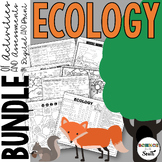The Nitrogen Cycle Cloze Reading Article with Diagram and Differentiation
- PDF
What educators are saying
Also included in
- Your students can use any biology curriculum bundle to learn about biology concepts, including characteristics of life, biochemistry, classification, cells, genetics, evolution, and ecology with any biology bundle. But, what if you had a full year of biology creative curriculum activities, assessmenPrice $230.00Original Price $404.25Save $174.25
- Your students can learn about ecology. But, do you have a unit bundle of differentiated ecology activities and assessments that best fit their learning needs? They can with this Ecology Activity and Assessment Unit Bundle. Most resources includes differentiation, digital, and printable options for lPrice $70.00Original Price $101.25Save $31.25
- Bundle and save and get a FREE resource with this bundle that allows your students to show their understanding of biogeochemical cycles with 3 different biogeochemical cycles cloze reading articles with diagrams and a FREE biogeochemical cycles double puzzle. Use the carbon cycle, nitrogen cycle, anPrice $9.50Original Price $12.50Save $3.00
Description
Your students could simply tell you that they understand the Nitrogen Cycle. They might can even tell you about a few steps of the process. But, can they show you that they know it by labeling and describing different steps of the Biogeochemical Cycle of Nitrogen? This activity is perfect for assessing your student's understanding of the various steps of the nitrogen cycle. Are you just starting to teach about the biogeochemical cycle? The cloze reading activity and diagram can be used as notes, too! The activity includes six differentiated versions of the worksheet, leveled with clues, a word bank, and no word bank versions of the resource. Not only is the resource differentiated but it comes with digital options, too! So, do you need a digital or print activity that will engage your students in showing what they know about the Nitrogen Cycle?
This cloze reading and diagram worksheet activity is just what you need to engage your middle and high school students in Biology or Life Science in an in-class or homework exploration activity. Earn favor with your administrators and meet individual student needs with the various levels of differentiation of the resource that you can use for gifted, honors, and students with disabilities. Furthermore, save yourself time with the no prep activity in print and digital.
But, don't just take my word for it. Check out what other teachers say about the Nitrogen Cycle Cloze Reading and Diagram Worksheet.
⭐️⭐️⭐️⭐️⭐️ "I appreciated the ability to differentiate for my learners. Very thorough information and presentation. Thank you!" -Carol
⭐️⭐️⭐️⭐️⭐️ "This resource helped me teach NGSS: Cycles of Matter in fifth grade. The included diagram is very helpful!" -Maria
⭐️⭐️⭐️⭐️⭐️ "This was an excellent resource that is highly adaptable for students at all levels. The nitrogen cycle is tough for students but they got the hang of it as they worked on filling in the blanks with a few hints from me..." -Erin
You Will Get:
- A low prep, print-and-go resource that saves you, the teacher, valuable time and energy and engages your students into showing what they know about the Nitrogen Cycle.
- A resource with a table of contents for easy organizing and printing.
- Six differentiated versions of the worksheet (clues, word bank, and no word bank)
- A How to Guide with ideas on engaging your students in the activity, use of the activity, further differentiation, and ways to incorporate technology.
- Digital options of the resource in Google Slides and TpT Easel.
- Answer keys.
You Will Like:
Biogeochemical Cycles Cloze Reading Bundle + FREE GIFT
The Carbon Cycle Cloze Reading and Diagram Worksheet
The Water Cycle Cloze Reading and Diagram Worksheet
Ecology BIG Bundle of Activities and Assessments
BIG Biology Bundle of Activities and Assessments (***Bundle and save over $100)
Feedback and Followers:
Did you know that you can receive credit towards future TpT purchases by reviewing this product? Leave a review at the product page after you download the resource or through “My Purchases”. Use your TpT credits that you earn to purchase other resources.
Do you want to be the first to know about new resources, sales, and free resources? Sign-up here to get email notifications and my Mix it Up Activities and Assessment eBook with templates. And don't forget to click the green star next to my store logo to become a follower. Connect in other ways using the links below! We love to see resources in action. Share them at @sciencefromthesouth to receive a FREEBIE!
Happy Teaching!
Heather








